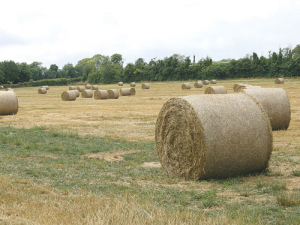Turning data into dollars
If growing more feed at home adds up to $428 profit per tonne of dry matter to your bottom line, wouldn’t it be good to have a ryegrass that gets you there quicker?
 In practice, silage is often not made at the optimal time, and little attention is paid to the silage-making process.
In practice, silage is often not made at the optimal time, and little attention is paid to the silage-making process.
Making high-quality pasture silage should not be difficult, but it must be viewed as a supplementary feed, rather than just a necessity to manage pasture.
NZ experimental results indicate that increasing silage quality by 2.3 MJ ME/kg DM increased MS production by 13, 17 and 41% in spring, summer and autumn, respectively. Higher quality feed will also increase BCS gain/kg DM eaten.
Making of silage should only be done from a true surplus and the objective is to preserve as many of the original nutrients as possible. In practice, however, silage is often not made at the optimal time, and little attention is paid to the silage-making process.
When grass is cut and left in a heap, it rots! Silage-making is the process of ‘pickling’ pasture to reduce the pH (acidity) to a level that stops the feed ‘rotting’ (i.e. stops microbial activity).
This is achieved through packing the pasture and covering it with plastic to exclude air, while microorganisms burn the sugars in the grass to produce lactic and acetic acid. If the silage is exposed to air (e.g. torn plastic) a chain reaction occurs that reduces silage quality.
Pasture silage can be made either in a field stack, a pit/concrete bunker (on top of the ground) or as bales. Provided the quality of the material going into the silage is the same and proper attention is paid to compacting and covering the pasture, pasture silage quality should be the same from either stack/pit or baled silage.
The decision to make bales or stack/pit silage is generally dependent on the farm system, the method of feeding silage and the infrastructure available for silage storage.
- Baled silage is more costly but enables flexibility of crop size and storage location onfarm and feeding out of small amounts on set occasions.
- Stack silage can also be stored in many locations and is cheaper than baled silage.
- Pit/bunker silage does not offer flexibility in storage but when properly used will result in less wastage. Pit silage is easier to compact and therefore to expel air.
One person intimately involved in the new legislation to replace the Resource Management Act (RMA) is the outgoing chief executive of the Ministry for the Environment, James Palmer, who's also worked in local government.
Horticulture New Zealand (HortNZ) says a new report projects strong export growth for New Zealand's horticulture sector highlights the industry's increasing contribution to the national economy.
Fonterra shareholders say they will be keeping an eye on their co-operative's performance after the sale of its consumer businesses.
T&G Global says its 2025 New Zealand apple season has delivered higher returns for growers, reflecting strong global consumer demand and pricing across its Envy and Jazz apple brands.
New Zealand's primary sector is set to reach a record $62 billion in food and fibre exports next year.
A new levying body, currently with the working title of NZWool, has been proposed to secure the future of New Zealand's strong wool sector.
President Donald Trump’s decision to impose tariffs on imports into the US is doing good things for global trade, according…
Seen a giant cheese roll rolling along Southland’s roads?